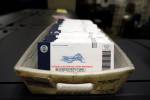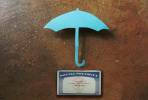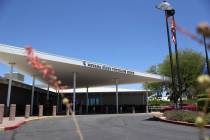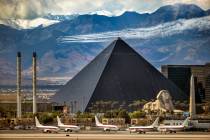Drones decision coming ‘soon’ from FAA

They have the parts to make it fly: knowledge and experience.
But Federal Aviation Administration officials at a conference this week in Las Vegas say their plan for allowing drones the size of those used by the military to share the skies with jetliners and general aviators still has unanswered questions.
They assured those at the convention that the answers will come “soon,” when they meet a mandate from Congress to designate six sites in the United States to demonstrate the compatibility of manned and unmanned aircraft.
They have been reviewing public comments on where their theories on safe air traffic control will be tested. They also are exploring how to certify the planes and “pilots” who would operate drones over populated areas by remote control.
And, they are mulling where they will draw the line between domestic spying and backyard privacy.
“Our goal is to safely and efficiently integrate unmanned systems into our airspace,” FAA Acting Director Michael Huerta told thousands of military and aerospace industry colleagues at a drone conference this week.
While expanding use of small, unmanned aircraft has “great opportunities,” he said, the task of integrating the airspace “presents significant challenges.”
“There are operational issues that we need to address … such as pilot training. We also need to make sure that unmanned aircraft see and avoid other aircraft and that they operate safely if they lose the link to their pilot,” Huerta said during the Association of Unmanned Vehicle Systems International conference at Mandalay Bay.
Jim Williams, the FAA chief in charge of guiding the effort to integrate the skies, said the civilian privacy issue is still in the air, considering that planes with near real-time video cameras are capable of spying like Air Force drones.
“I confirm that we’re figuring out exactly how I’m going to manage that issue,” Williams said after a “hot topic” presentation Wednesday afternoon.
“It’s being discussed at the highest levels of the government.”
He said hundreds of citizens and entities responded to FAA’s request for comments on siting six test ranges. In April, more than 800 participated in two online sessions.
“It was amazing the response. We got surprised,” he said.
The FAA expects to report to Congress on its proposal to create rules early next year.
“People are looking into your backyard whether you like it or not,” said Charles Michalec, a former Predator pilot.
He suggested the privacy issue could best be addressed by focusing on guidelines for the use of high-tech cameras and sensors mounted on government and civilian UAVs rather than attacking the unmanned aerial vehicles themselves.
Restrictions could be placed on the resolution of the images instead of directly on remotely piloted aircraft operations.
After all, privacy concerns have been around since the days of observation balloons and blimps. Today’s manned helicopters can capture images as they fly at relatively low altitudes over populated areas.
Williams said he envisions an airspace integration plan that is not only safe and efficient but is timely for tapping the multibillion-dollar industry that will add to the 10 million jobs that civilian aviation accounts for and the $1.3 trillion it contributes to the U.S. economy.
“If we don’t create a welcome atmosphere for UAS (unmanned aerial systems), then the business will go elsewhere,” he said, referring to foreign competition.
Huerta said the FAA must meet the expectations of the public agencies and civilian population it serves.
“It’s about leveraging technology to improve the way we do business for the traveling public, for airlines, for airports and the environment,” which are all part of the FAA’s next generation plan.
Spearheaded by technology developed for the military, drones have proven their worth to law enforcement, search-and-rescue, firefighting, border patrol, and tracking and assessing wildlife in remote, harsh conditions.
In January, the FAA approved an emergency use for a 3-pound, unmanned aircraft, known as the “flying king crab” because of its legs for landing, to survey ice ridges and send back photos in Alaska so that a tanker ship could reach the harbor through hazardous ice to deliver fuel to Nome’s 3,500 residents.
By August 2013, the FAA must establish two permanent operation areas in the Arctic for unmanned aircraft to accommodate flights over water of at least 2,000 feet altitude for research, commercial and civilian use. The designated Arctic airspace could benefit scientific research, studies of marine mammals, fisheries management and search-and-rescue operations. It also could serve oil and gas leaseholders whose drill rigs might be threatened by iceberg movements.
Overall, Huerta said the task to integrate the skies is daunting.
“Unmanned aircraft systems are inherently different from manned aircraft. They run a very wide range, with a number of different physical characteristics. Some are the size of a fist and fly at low altitudes. Others have gliderlike bodies with the wing span of a 737 (jetliner) and can fly above 60,000 feet,” he said.
Huerta said that the FAA has historically risen to the challenge of “integrating innovation” including powerful jets with propeller-driven aircraft in the 1950s and ’60s, wide-body jumbo jets with supersonic passenger jets in the 1970s.
He said the FAA is making the transition from radio messages to more reliable messages that appear as text on a screen and moving away from airways that zigzag the nation to streamlined routes that save time and fuel.
“Innovation is what spurs aviation to new heights. It’s what makes America great,” Huerta said.
“Building new technology is one thing. Building human consensus on a path forward for our aviation system is an equally important task. There is a lot of work that needs to be done.”
Contact reporter Keith Rogers at krogers@reviewjournal.com or 702-383-0308.


















